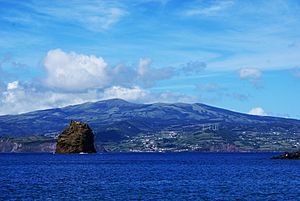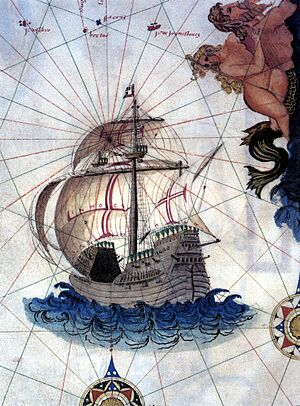Action of Faial facts for kids
Quick facts for kids Action of Faial |
|||||||
|---|---|---|---|---|---|---|---|
| Part of the Anglo–Spanish War | |||||||
 Faial Island, off which the action was fought |
|||||||
|
|||||||
| Belligerents | |||||||
| Commanders and leaders | |||||||
| Francisco de Melo Canaveado | Earl of Cumberland | ||||||
| Strength | |||||||
| 1 carrack of 2,000 tons 700 men |
3 galleons of 250–300 tons 420 sailors |
||||||
| Casualties and losses | |||||||
| 1 carrack destroyed 600 killed or wounded 13 survived/captured |
60 killed or wounded (35 killed in explosion) | ||||||
The Action of Faial was a big naval battle. It happened on June 22-23, 1594. This fight was part of the war between England and Spain. A huge Portuguese ship, the Cinco Chagas, was destroyed. This ship was full of valuable treasure. The battle took place near Faial Island in the Azores. The ship exploded, so no one got the treasure.
Contents
Why the Battle Happened
At this time, Spain and Portugal were united under one king. This was called the Iberian Union. Because of this, English ships could attack Portuguese ships. The war between England and Spain was still going on.
The Earl of Cumberland was an English nobleman. He wanted to find rich ships, like one captured a year before. So, he prepared three of his own ships. These ships were between 250 and 300 tons. They had two decks for cannons. About 420 sailors and soldiers were on board. His ships were the Royal Exchange, the Mayflower, and the Sampson. A smaller support boat, the Violet, also joined them.
On April 6, 1594, the English fleet left Plymouth, England. They sailed towards the Azores islands. On their way, they sailed along the coast of Portugal and Spain. They captured several smaller ships. Near Viana do Castelo, Portugal, they took a small 28-ton ship. It was heading to Portuguese Angola. Near the Berlengas islands, they captured three more Portuguese and Spanish ships. One had wine, and another had a small chest of silver. These captured ships were sent back to England. The rest of the fleet continued towards the Azores. They hoped to avoid the Spanish fleet. The Spanish fleet was looking for Cumberland.
On June 22, 1594, the English ships neared Faial Island. The Mayflower spotted a very large ship. It was a huge Portuguese carrack. This ship was the Cinco Chagas, meaning "Five Wounds." It had 32 cannons and weighed 2,000 tons. The Cinco Chagas had left Goa, India, in 1593. It was heading for Portugal. People said it was one of the richest ships ever to sail from India. It carried many precious stones and valuable goods.
Two other ships had left Goa with the Cinco Chagas. But they had problems and were beached in Mozambique. So, the Cinco Chagas took on their cargo. This included diamonds and other gems. It also took on 400 passengers and crew. Many of these were slaves. Two important people were also on board. They were a former governor of Mozambique and a fleet captain.
The Chagas stopped in Luanda, Portuguese Angola, for supplies. They took on even more slaves there. By the time the Chagas reached the Azores, many people had died from disease. Much of their food was thrown overboard to lighten the ship during storms. The carrack tried to reach Corvo for more supplies. But strong winds stopped them. So, they sailed towards Faial. Soon, the lookouts on the Chagas saw the English ships. They got ready for battle.
The Battle Begins
Around noon, all four ships started firing their cannons. They also shot muskets at each other. The battle lasted for almost a whole day. The English ships tried to get close to the Cinco Chagas. They wanted to board it. But the Portuguese had more men and fought them off. Many people were hurt or killed on both sides. The decks of the carrack were covered with dead and wounded.
The English tried to board the ship three times. Each time, the Portuguese fought them back. They knew the treasure was too important to lose. George Cave, the captain of the Mayflower, was killed. This made his crew lose hope. The crew of the Sampson also faced heavy losses. The fighting continued for hours. The four ships were tied to each other. Soon, the other two English ships, the Mayflower and Sampson, drifted away. They had lost hope of taking the Chagas. Nicholas Downton was badly hurt. William Antony was also hurt and later died.
However, the English noticed something important. The Cinco Chagas had no cannons at its back. So, the English ships returned to attack. They focused their fire on the back of the carrack. The Royal Exchange tried to board again. This time, they succeeded after fierce fighting. While the hand-to-hand fighting was happening, a fire started. It began on a canvas cover. Then it spread to the ship's ropes and masts. The fire could not be put out. English sharpshooters kept shooting Portuguese sailors. These sailors were trying to use the water pumps.
The fire grew out of control. The English were winning. The Portuguese decided to leave the ship. They grabbed anything that could float. At the same time, English sailors came in small armed boats. They started shooting or attacking the Portuguese in the water. Some women tried to escape. They took off their outer clothes. They hoped the English would show them mercy. However, one lady, Dona Isabel Pereira, and her 16-year-old daughter, Dona Luisa, refused to undress. They tied themselves together with a rope. Then they jumped into the sea. Their bodies washed ashore on Faial the next day. They were still tied together.
When the fire became completely out of control, the English pulled their ships away. They worked hard to untie their ships from the Chagas. The carrack burned all through the night. Just after dawn, the flames reached the powder room below deck. It held 60 barrels of gunpowder. The gunpowder exploded. The ship blew apart. Most of the ship's pieces floated on the water.
The explosion was huge. Hundreds of Portuguese people died. This included men, women, and children. About 35 English sailors who were still on board also died. Most were killed instantly. The battle ended with the complete loss of the Chagas and its valuable cargo.
After the Battle
The English crew tried to find useful floating pieces. But there was very little. The English then picked up survivors. Only thirteen Portuguese out of 600 survived. The English fleet then sailed west. They hoped to find more rich ships. Two weeks later, they saw another carrack, the San Fellipe. But the English had already lost many men to disease. Their officers were hurt or killed. Supplies were low. A storm was also pushing them apart. So, Cumberland decided not to attack. He sailed home.
The cargo of the Cinco Chagas was worth a huge amount of money. It had diamonds, rubies, and pearls. Experts in 2017 estimated its value to be around US$15–20 billion. The captured Portuguese survivors told the English that giving up was impossible. This was because the riches belonged to the King of Spain and Portugal. They said their captain would have become a viceroy in India if he had returned safely.
The Chagas was destroyed. So, Cumberland was satisfied that the Portuguese and Spanish did not get the riches. He successfully avoided the Spanish navy. The Spanish fleet failed to find him. This was partly because they were protecting other treasure ships. Another Spanish fleet also failed to find the English.
The English fleet arrived in Portsmouth, England, on August 28. The Queen's soldiers searched the ships very carefully. This was because of a lot of theft from another captured ship two years earlier. The two important Portuguese men, Dom Nuno Velho Pereira and Dom Braz Correia, survived the explosion. They were brought ashore as prisoners. The Earl treated them well. They stayed as his guests for a whole year. Then, they were set free for a ransom. Pereira paid for both of them. This meant Cumberland's trip in 1594 earned him some money. With this money, the Earl decided to build a new, bigger ship. He did not need to borrow from the Queen. The new ship was launched in 1595. The Queen named it the Scourge of Malice.
What We Remember
A Venetian ambassador to Spain said the Cinco Chagas was the richest ship ever to sail from the East Indies.
People believe the wreck of the Cinco Chagas lies in the Atlantic Ocean. It is about eighteen miles south of the channel between Pico Island and Faial. The water there is over a mile deep. The ship's precious cargo of diamonds and gems is still there. Treasure hunters have looked for the wreck. But they have found no signs of it. This is partly because of how deep it is.
See Also
Anglo-Spanish War (1585–1604) Carrack
Images for kids




